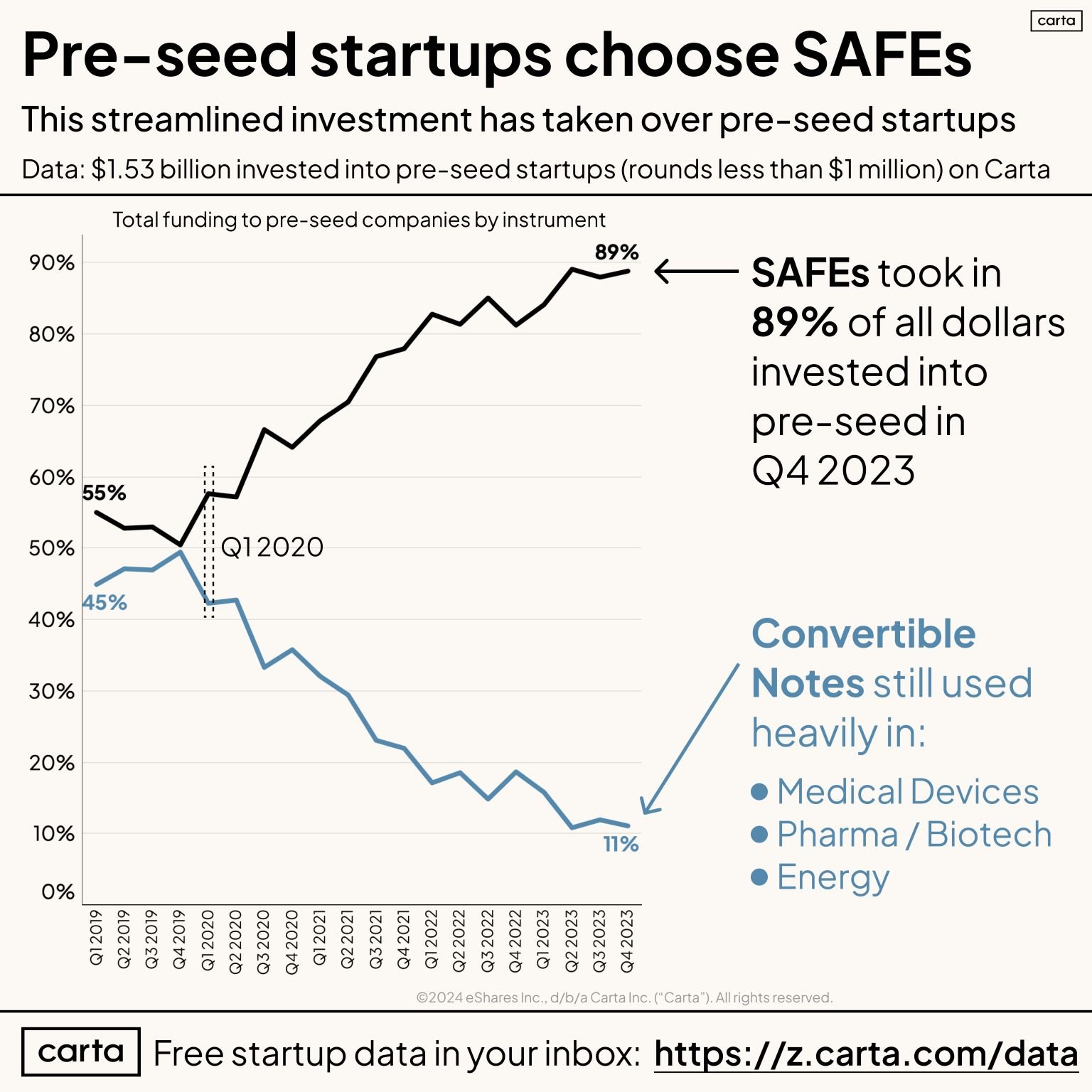What is Pre-Money Valuation?
By Lior Ronen | Founder, Finro Financial Consulting
So you decided to raise funds for your brilliant startup, huh?
You need a valuation, but have you heard there are actually two types of valuations?
Pre-money and post-money? Don't be confused. We're going to clear this out, real nice.
In this article, we're going to walk you through what pre-money valuation really means and why it's such a big deal. We'll also clear up any confusion between the pre-money valuation with stuff like post-money valuation and pre-revenue valuations.
This stuff matters a lot when it comes to who owns what in your company and how investors get involved. So, whether you're dreaming of launching your own startup or you're an investor trying to get the hang of all this valuation talk, stick with us.
We've got you covered on all things pre-money valuation in the world of venture capital.
Pre-money valuation is a critical financial assessment for startups, determining their worth before receiving new investments. This valuation is influenced by factors such as market potential, team experience, product stage, and competition. Common methods to calculate pre-money valuation include Comparable Company Analysis and Discounted Cash Flow Analysis.
The concept is distinct from pre-revenue valuation, which applies to startups without sales, focusing on future potential rather than current financials. Accurate pre-money valuation is pivotal in shaping a startup's financial strategy, attracting suitable investors, and guiding its growth and success in a competitive market.
- What is Pre-Money Valuation?
- Why Pre-Money Valuation Really Matters?
- Pre-Money vs Post-Money: Understanding the Differences
- Difference between Pre-Money and Post-Money Valuations in Terms of SAFE Agreements
- What Affects Your Startup's Pre-Money Valuation?
- Methods to Calculate the Pre-Money Valuation of a Startup
- Pre-Money Valuation vs. Pre-Revenue Valuation: Understanding the Difference
- Conclusion
What is Pre-Money Valuation?
Alright, let's get down to brass tacks: what exactly is pre-money valuation? In the simplest terms, pre-money valuation is the value assigned to your startup before any new investments are added. It's the estimated worth of your company in its current state, without any additional funding included.
Think of pre-money valuation as your startup's 'before' picture in the world of finance. It's the snapshot of your company's value before any of the investment magic happens.
And how's this different from post-money valuation? Here's the deal: post-money valuation is like the 'after' picture. It's what your company is worth after those investment dollars are added to the equation. If pre-money valuation is your startup's worth before investment, post-money valuation is what it’s worth after the investment.
For example, if your startup has a pre-money valuation of $1 million, and an investor gives you $500,000, your post-money valuation becomes $1.5 million. It's like your company just got a financial glow-up thanks to that investment.
In short, pre-money valuation sets the stage. It's crucial because it determines how much of your company you'll trade for that investment. Getting this number right is key to paving a smooth path for your business's financial journey.
Startup valuation is the process of determining the worth of a startup company, often a critical aspect for both entrepreneurs and investors, especially during funding rounds. This valuation considers various factors, including the startup's current financial performance, market potential, team expertise, product or service uniqueness, and the competitive landscape.
Different methods are used for valuation, such as Comparable Company Analysis, Discounted Cash Flow, and more, each suitable for different stages of the startup's life cycle. Valuation not only influences how much investment a startup can attract but also determines the equity share that founders give up to investors. Accurate valuation is essential for startups to secure funding, negotiate with investors, and guide strategic decisions for future growth and scalability.
Read more
Why Pre-Money Valuation Really Matters?
So, we've got a grip on what pre-money valuation is, but why is it such a big deal when raising funds?
Let's dive into that.
First off, pre-money valuation is like the cornerstone of your funding round. It's crucial because it pretty much decides how the pie is sliced – the pie being your company's equity.
A higher pre-money valuation means you can raise more money without giving away too much of your company.
On the flip side, a lower valuation might mean parting with more shares than you'd like.
Think of it this way: the pre-money valuation sets the stage for how much of your startup you retain and how much your investors get. It’s not just about the money; it’s about control too. If you value your company too low, you risk losing a bigger chunk of your business to investors. Value it too high, and it might be hard to find investors willing to bite.
And here’s another thing – investor returns. The pre-money valuation impacts how much return investors can expect. A lower pre-money valuation can mean higher potential returns for investors since they get more equity for their buck.
This can be a sweet spot for attracting investors, but remember, it's a balancing act. You want investors on board, but you also want to keep enough of your company to stay motivated and in control.
In short, nailing the pre-money valuation is key. It’s not just a number game; it’s about finding that sweet spot where both you and your investors feel you’re getting a fair deal.
Pre-Money vs Post-Money: Understanding the Differences
The distinction between pre-money and post-money valuations is pivotal in the landscape of startup financing, directly impacting the equity distribution between founders and investors.
Pre-money valuation refers to the company's valuation before the infusion of new capital, serving as a benchmark to determine the equity investors receive for their investment.
Post-money valuation, conversely, adds the newly invested funds to the pre-money valuation, offering a post-investment worth of the company.
This differentiation is more than academic; it has practical implications for both founders and investors. For founders, understanding this distinction is crucial in negotiations, as it influences their ownership dilution.
A higher pre-money valuation means less equity is given away for the same amount of investment, preserving greater control over the company.
For investors, the post-money valuation is indicative of their stake in the company post-investment, influencing their decision-making process based on potential returns.The calculation is straightforward but its implications are profound.
To put these concepts into perspective, consider a startup with a pre-money valuation of $4 million. If an investor contributes $1 million, the post-money valuation becomes $5 million. Here's how it impacts equity:
Pre-investment, the company is valued at $4 million.
Post-investment, with the additional $1 million, the company's worth rises to $5 million.
The investor's $1 million contribution for a $5 million post-money valuation translates to a 20% ownership stake in the company.
This valuation dynamic also shapes investment strategies and negotiations.
Founders must approach valuation with a comprehensive understanding of their company's worth and growth trajectory, backed by robust financial models and market analysis.
Investors, on the other hand, will evaluate the pre-money valuation against potential market growth, the startup's competitive edge, and the team's capability to execute the business plan, adjusting their offered terms accordingly.
In essence, the pre-money and post-money valuations are not just numbers but reflections of a startup's strategic positioning and the mutual expectations between founders and investors.
A nuanced understanding of these valuations facilitates informed decision-making, aligning interests towards a common goal of company growth and success.
Difference between Pre-Money and Post-Money Valuations in Terms of SAFE Agreements
In 2023, 89% of pre-seed funding rounds chose to raise capital through Simple Agreements for Future Equity (SAFEs), underscoring their significant popularity and application in the startup financing landscape.
A SAFE is an investment contract that allows startups to secure funding from investors without immediately determining a company's valuation or issuing equity. Instead, SAFEs convert into equity at a later financing event, typically during a priced funding round, based on specific terms agreed upon by both parties.
A valuation cap is a crucial term within a SAFE agreement, setting an upper limit on the valuation at which the SAFE converts into equity.
This cap is designed to reward early investors for their risk by ensuring they receive equity at a more favorable price if the company's valuation increases significantly by the time of conversion. The valuation cap effectively determines the maximum valuation used for converting the SAFE into equity, protecting investors from dilution in high-growth scenarios.
These financial instruments, characterized by their flexibility and simplicity, have reshaped early-stage fundraising by streamlining the process and aligning the interests of founders and investors.
Understanding SAFEs and valuation caps is essential for navigating the complexities of startup financing, ensuring both parties achieve a fair and advantageous outcome.
The distinction between pre-money and post-money valuations becomes particularly relevant in the context of SAFE agreements due to their unique impact on equity distribution and company valuation at the time of conversion.
A pre-money SAFE agreement sets the valuation cap before the investment, thereby determining the company's valuation for the purposes of the SAFE conversion before new funds are added. This approach favors founders by allowing them to retain a larger portion of equity post-investment, assuming the company's valuation at the time of conversion exceeds the cap.
Conversely, a post-money SAFE includes the investment amount in the valuation cap calculation, offering a clearer picture of the post-investment ownership structure. This method benefits investors by providing a transparent understanding of their equity percentage following the conversion of the SAFE into equity, factoring in the investment amount.
Understanding the nuances between pre-money and post-money valuations in SAFE agreements is critical for both founders and investors to navigate equity distribution and valuation implications effectively.
This knowledge ensures informed decision-making, aligning expectations, and fostering equitable investment partnerships.
| Attribute | Pre-Money SAFE | Post-Money SAFE |
|---|---|---|
| Valuation Cap | Sets an upper limit on the valuation at which the SAFE converts, not including the amount invested. | Sets an upper limit on the valuation at which the SAFE converts, including the amount invested. |
| Conversion Mechanics | Converts into equity at the next financing round using the pre-money valuation cap as the baseline. | Converts into equity considering the post-money valuation, which factors in the SAFE investment. |
| Equity Dilution | Investors' equity percentage is calculated without the SAFE investment, potentially leading to more favorable terms for investors. | Provides a clearer picture of dilution by including the investment in the valuation calculation. |
| Investor Benefit | Offers early investors potentially higher equity stakes if the startup's valuation increases significantly. | Gives investors a transparent understanding of their equity stake post-conversion. |
| Founder Perspective | May result in less dilution if the company's valuation at conversion is high, preserving founder equity. | Can provide more certainty regarding ownership structure after investment. |
| Use Case | Favored in scenarios where startups and investors are willing to defer valuation discussions. | Preferred when both parties seek clarity on post-investment ownership percentages. |
What Affects Your Startup's Pre-Money Valuation?
Understanding what drives your startup's pre-money valuation can feel a bit like detective work. It's not just a random number; several crucial elements shape this valuation.
Let's dive deeper into these factors:
Market Potential: This is all about the size and growth potential of the market you're targeting. Are you tapping into a niche market or aiming for a broader audience? The bigger and more rapidly growing your market is, the more valuable your startup appears to investors.
They're looking for businesses that can scale up and capture a significant market share. So, if you've got evidence that your market is expanding and your product or service has a wide appeal, your valuation could soar.
Team Experience: Here, we're talking about the people behind the scenes – you and your co-founders or key team members. Investors often bet on the jockey, not just the horse. They want to know if you've got the experience, skills, and track record to turn your startup into a success.
Have you or your team members built successful companies before? Do you have industry-specific knowledge or unique skills that set you apart? A strong, experienced team can significantly elevate your startup's valuation.
Product Stage: Where is your product in its lifecycle? Is it just an idea, a prototype, or do you have a fully functional product with paying customers? The further along your product is in development, the better.
A product that's already in the market with a good user base and positive feedback is a lot less risky for investors. It shows that there's a demand for what you're offering, which can justify a higher valuation.
Competition: The competitive landscape plays a big role too. Are you the only player in your niche, or are there several companies fighting for the top spot? While high competition can be challenging, it can also validate the market.
However, if you have a unique advantage – like proprietary technology, exclusive partnerships, or patents – that sets you apart from the competition, it can be a huge boost to your valuation. It's all about showing that you have an edge that makes your startup a better bet than the others.
Each of these factors tells a story about your startup's potential and risks. Investors will weigh these aspects to decide how much they believe your company is worth before they invest. So, it's crucial to understand and communicate these elements effectively when you're discussing valuation.
Methods to Calculate the Pre-Money Valuation of a Startup
Calculating the pre-money valuation of a startup involves a mix of art and science, with various methodologies employed based on the stage of the company, available data, and market conditions.
Here are some of the most commonly used valuation methods:
1. Comparable Company Analysis (CCA)
This method involves comparing the startup to similar companies in the industry that have recently been valued or gone through funding rounds.
By analyzing these comparables, startups can benchmark their valuation against those of peers with similar metrics such as revenue, growth rate, and market position.
This approach requires access to data on comparable companies, which might not always be available or fully transparent.
2. Discounted Cash Flow (DCF) Analysis
DCF analysis is a more quantitative method that forecasts the startup's future cash flows and discounts them back to their present value, using an appropriate discount rate that reflects the risk of the business.
This method is data-intensive and relies on the accuracy of cash flow projections, making it more suitable for startups with an established revenue model and predictable financials.
3. Venture Capital (VC) Method
The VC method calculates pre-money valuation by estimating the future exit value of the startup and working backward to the present, accounting for the desired return on investment for the venture capitalists.
This method is particularly relevant in early-stage startup valuations, where long-term growth potential is a significant factor.
It involves determining an expected rate of return and projecting the company's exit valuation, based on industry averages and growth expectations.
4. Berkus Method
Designed for early-stage startups without significant financial history, the Berkus Method assigns value to key success factors outside of financial projections, such as the quality of the management team, the size of the opportunity, product innovation, strategic relationships, and sales and marketing channels.
Each factor is assigned a monetary value, up to a set maximum, and the total provides a valuation.
5. Scorecard Method
Similar to the Berkus Method, the Scorecard Method evaluates a startup by comparing it to average valuations of recently funded startups in similar stages and sectors.
It adjusts the valuation based on factors such as management team, size of the market, product or technology, competitive environment, marketing/sales channels, and the need for additional financing.
Each factor is weighted differently and the overall score adjusts the baseline valuation to estimate the startup’s worth.
Each of these methods has its strengths and limitations, and in practice, a combination of approaches is often used to triangulate a fair pre-money valuation.
The choice of method depends on the nature of the startup, the availability of data, and the context of the valuation exercise.
It's also important to note that valuation is not just a numerical exercise but also involves negotiation between the founders and the investors, influenced by market conditions and investment climate.
Pre-Money Valuation vs. Pre-Revenue Valuation: Understanding the Difference
It's easy to get tangled up in the jargon of startup financing, especially when it comes to understanding pre-money valuation and pre-revenue valuation. Let's untangle these terms and see how they differ.
First up, pre-revenue valuation. This is a term used for startups that haven't started making money yet. They have no sales, no cash flow – just an idea, a product in development, or maybe a prototype.
Valuing these companies is tricky because traditional valuation methods usually rely on financial performance, which pre-revenue startups don't have. So, how do you put a price on potential?
Investors often look at the team's experience, the market size, the product's innovation, and the competitive landscape. It's more about betting on the future than measuring current financial success.
Now, let's talk about how this is different from pre-money valuation. Pre-money valuation is all about how much your company is worth before any new investment comes in, regardless of whether you're making money or not.
It's possible for a pre-revenue company to have a high pre-money valuation if investors believe in its potential to generate revenue in the future.
So, when do we evaluate pre-revenue companies? Typically, during early investment rounds like seed or Series A, where the focus is on the startup's potential rather than its current earnings.
The challenge here is convincing investors of your future success without a track record of revenue. This is where factors like a unique business model, market demand, and potential for scalability come into play.
The relationship between a company's revenue status and its pre-money valuation is nuanced. A pre-revenue company can still have a high pre-money valuation if it shows promise for future profitability, but it might face more skepticism and require more convincing compared to a company with steady revenue streams.
| Aspect | Pre-Revenue Valuation | Pre-Money Valuation |
|---|---|---|
| Definition | Valuation of startups with no sales or revenue. | Valuation of a company before any new investments are made. |
| Focus | Potential of the business idea and future success. | Current value of the company based on various factors. |
| Used During | Early investment rounds like seed or Series A. | Any investment round, regardless of the company's revenue. |
| Evaluation Based On | Team's experience, market size, product innovation, competitive landscape. | Financial performance, market potential, team, product stage, competition. |
| Challenges | Convincing investors of future success without a revenue track record. | Balancing investor expectations with company's valuation needs. |
| Relation to Revenue Status | Can have a high valuation based on potential for future profitability. | Reflects current worth; may be higher if the company already generates revenue. |
Conclusion
As we've seen, understanding pre-money valuation is crucial for any startup embarking on the journey of fundraising. It's not just a number pulled out of thin air; it's a reflection of your startup's potential, market position, team strength, and so much more.
From the early stages of pre-revenue valuation, where potential and innovation take the front seat, to the more mature stages where financial metrics come into play, each step in determining pre-money valuation is a critical piece of your startup's financial puzzle.
Remember, getting your pre-money valuation right sets the tone for your funding rounds. It influences everything from how much equity you retain to the kind of investors you attract. As much as it's about the numbers, it's also about the story you tell - the vision of your startup and the promise it holds.
So, whether you're a budding entrepreneur or an investor, keep these insights in mind. Understand the factors that drive valuation, grasp the nuances between different valuation types, and always strive for a fair and realistic assessment of your startup's worth.
With this knowledge, you're better equipped to navigate the exciting, sometimes challenging world of startup financing. Here's to your success in turning those bold dreams into reality!



































